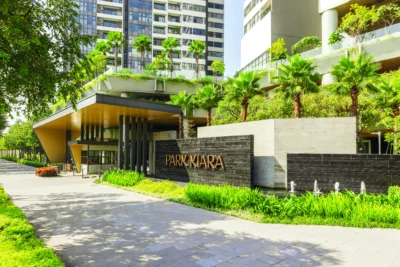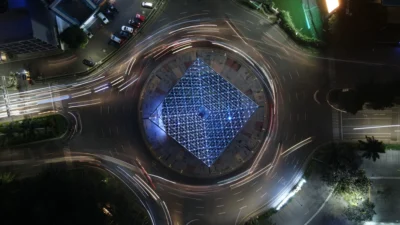Bali through the eyes of starchitect Jean-Michel Gathy
As the masterplanner and designer of several components at Bukit Pandawa Resort & Golf, the Belgian architect has the chance to put his stamp on the island

Few names in the world of hotel design are as recognizable as Jean-Michel Gathy. Indeed, the cultured, 61-year-old Belgian has designed for most major super-luxury hotel brands.
But his latest endeavour could just trump them all. With 150 cliff-top hectares to play with on Bali’s southernmost tip, Gathy has conceived a multi-faceted resort—called Bukit Pandawa Resort & Golf—that seizes on its location in the most artful of ways.
Here, Denniston Architects’ principal designer talks about what drew him to Bukit Pandawa, why it will be unlike any other resort project in the world, why he would never eat an entire box of chocolate (seriously), and more.
How did the opportunity to masterplan Bukit Pandawa Resort & Golf come about?
A few years ago, a gentleman by the name of Tjian An (President/Director of Bukit Pandawa Resort & Golf’s ownership group, PT Bali Ragawisata) came to me and said, “We have 150 gorgeous hectares on the south coast of Bali and we would like for you to come and see it.” So I did, and I adored it. We’re talking two kilometres of seafront, with land sloping perfectly down toward a 70-metre-high cliff overlooking a beach and the ocean. I thought the topography was hospitable for development as every square foot was usable, which is extremely unusual. Also, I could see there would be no major inconvenience, with the rolling hills set between the coastal road and the ocean. No interruptions, and only glorious views.
What are the key components?
There will ultimately be four hotels, including the first Mandarin Oriental hotel in Bali, which our company, Denniston, designed. There will also be a Waldorf Astoria, a Swissôtel and another world-class hotel we cannot divulge the name of yet. They will all be “linked” by a championship-calibre golf course that is already open. And on the highest part of the property, you’ll have 91 of the most amazing villas—The Residences at Mandarin Oriental Bali.
Why is having something that links the hotels together important?
With any sprawling property like this, you must have what I call a vector. And the vector here is the 18-hole, executive golf course, which you’ll be able to see from the front or back of the hotels. The ownership group hired an American golf course designer, Bob Moore (of JMP Golf in California), who did a magnificent job in fine-tuning our routing concept into an extraordinary, all-par-3 golf design you are able to play within two hours instead of the four or five hours a standard golf course requires. I think for many people, that’s a very nice amenity.
What will make the Mandarin Oriental, Bali, and The Residences at Mandarin Oriental, Bali, unique?
The Residences at Mandarin Oriental, Bali, will occupy a dream-like spot on the property, behind the Mandarin Oriental, Bali. Because of the topography, The Residences will have the most magnificent, unobstructed sea views during the day. Then, when night falls and the ocean goes dark, you’ll experience the full effect of a lighting system that is simply remarkable. The developers hired a world-class lighting consultant—Flaming Beacon from Australia—to implement a lighting scheme that will serve both the hotel closer to the cliff and create an extraordinary foreground decor for The Residences. You will not have a high-rise building impeding the view for The Residences. You will have interplay between the 88, one-level room pavilions and nine hectares of tropical landscape.
What other features will Bukit Pandawa possess?
There will also be a free-standing small village near the Swissôtel Bali, which is designed to be more interactive and lively and young and fun. The Waldorf Astoria will be located proudly along the cliff’s edge and relatively close to the Swissôtel. The village will have absolutely no influence on any of the hotels, though. We’ll have higher density in one corner—but still low density compared to most projects in the world—and lower density as you move away from the village and especially at the other end of the property where a 43-room boutique hotel is to be located. The furthest east corner of the property is adjacent to the Pura Dhang Kahyangan Gunung Payung Temple, one of Bali’s most magnificent and revered temples.
How did you manage to fully utilize the land’s potential?
One of the ways to fully utilize a piece of land is to use topography intelligently. When you design a property where you want every square foot to be maximized, you have to have a gorgeous layout or architectural design, but the topography is what actually gives you the edge.
To the credit of the owners, they understood that. I suggested that we cut into the cliff in the front so we could fill and lift the back of the site, and they agreed. So from land that was gently sloping, we now have land that is quite steep. We actually cut 20 metres of the cliff in certain places. So you drop 20 metres in the front and lift 20 metres in the back, and what you have done is increased by 40 metres the difference in level between the front and the back of the property. This makes for magnificent benefits in terms of views.
How have you incorporated Balinese style into this project?
This is the thing. There are so many hotels in Bali, and so many have the same sorts of design elements—such as the thatched roof, because obviously it is so Balinese. But when you do too much of something…well, let me just explain it like this: I like chocolate. But when I have my coffee, I have just one piece of chocolate, not 10 pieces. If you make me eat the box, I would vomit. It’s just too much!
So what, then, is the right amount of ‘Bali’?
We have reached a time in Bali where we have to start distilling Balinese architecture a little better. So what we’ve done is kept and respected all the values of Balinese culture—the ceremony of the bath, the respect for the head of the village, the sequences of entry in the courtyard, the type of double doors, etc. But we’ve used them in a contemporary fashion.
Across all properties, or just the Mandarin Oriental, Bali, and The Residences at Mandarin Oriental, Bali?
All of the hotels will be extremely respectful of Balinese values and culture. But we have to have a little bit of a touch from today. We all need our high-speed Internet, a proper shower, etc. So we’ve made sure that the softness of our developed life is included. These properties are very sexy and slick in terms of design, but they are all inherently Balinese. After all, you don’t come here to feel like you’re in London. The landscape, the interior, the furniture, the architecture—all of it has been considered with respect and in line to what defines Bali.
This article originally appeared in Issue No. 148 of PropertyGuru Property Report Magazine
Recommended
Park Kiara in Hanoi raises the bar for sustainable urban living
Park Kiara in Hanoi is a repudiation of low-density, car-dependent suburban sprawl
6 reasons Bekasi is rising as Greater Jakarta’s next hotspot
One of Greater Jakarta’s rising stars is prospering, thanks to ample recreation and a contingent of desirable housing projects
6 developments driving Asia’s green real estate shift
Developers are being incentivised to push a green agenda into daring new realms
The Philippines’ LIMA Estate drives sustainable industrial growth
LIMA Estate models a citywide vision that uplifts workers while appealing to climate-conscious employers










